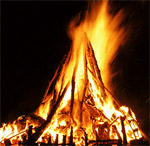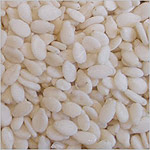A host of interesting traditions have ritualistically been performed over the years to mark the joyous Punjabi occassion known as Lohri. What are these Lohri traditions and why are they observed from generation to generation? To know more, check out our engrossing article on Lohri traditions and celebrate the occassion. If you like reading about Lohri traditions and want to refer this article to your friends and loved ones, you have only to make a click here and pass them on this page. Have a grand Lohri celebration!
 The actual celebration of Lohri begins days before the actual festival. A few days prior to the occassion, some of the girls in every village group together and visit every house singing something like: "We've come, all the girls of the village! We've come to your courtyard!." Their objective is to ask for gobar (cow-dung cakes), a natural fuel used in every village for cooking purposes. At the end of the morning, a large pile of cow-dung cakes is collected which is heaped in one of the homes in the village. On the actual festive day, this is used to create a small idol of the goddess Lohri. The idol is then decorated, a bonfire lighted before it and praises of the goddess are chanted.
The actual celebration of Lohri begins days before the actual festival. A few days prior to the occassion, some of the girls in every village group together and visit every house singing something like: "We've come, all the girls of the village! We've come to your courtyard!." Their objective is to ask for gobar (cow-dung cakes), a natural fuel used in every village for cooking purposes. At the end of the morning, a large pile of cow-dung cakes is collected which is heaped in one of the homes in the village. On the actual festive day, this is used to create a small idol of the goddess Lohri. The idol is then decorated, a bonfire lighted before it and praises of the goddess are chanted.
The bonfire lighted before Goddess Lohri is another important custom associated to the festival.
 The fire is lit at sunset and represents the sun-god, the source of physical and spiritual energy. Huge bonfires are lighted in the harvested fields and in the front yards of houses in every Punjabi village. Celebrants encircle the fire (an action known as "parikrama") and toss food items like sesame seeds, gur, sugar-candy, puffed rice, popcorn and rewaries into it as sacred offerings. Enthusiastic words like "Aadar aye dilather jaye" (May honor come and poverty depart!) are shouted out as a prayer to the fire god, popular folk songs are sung and even dances in the traditional "Bhangra" and "Gidda" style are performed. Once the fire subsides and the celebration ends, the celebrants take home the dying embers from the fire which is believed to bring abundance and prosperity.
The fire is lit at sunset and represents the sun-god, the source of physical and spiritual energy. Huge bonfires are lighted in the harvested fields and in the front yards of houses in every Punjabi village. Celebrants encircle the fire (an action known as "parikrama") and toss food items like sesame seeds, gur, sugar-candy, puffed rice, popcorn and rewaries into it as sacred offerings. Enthusiastic words like "Aadar aye dilather jaye" (May honor come and poverty depart!) are shouted out as a prayer to the fire god, popular folk songs are sung and even dances in the traditional "Bhangra" and "Gidda" style are performed. Once the fire subsides and the celebration ends, the celebrants take home the dying embers from the fire which is believed to bring abundance and prosperity.
Once the "parikrama" is finished, the prasad (food offering) is distributed among the people. This prasad primarily consists of five items: til, gajak, jaggery, peanuts, and popcorn. Partaking the "prasad" is considred to be an auspicious action that supposedly brings good fortune and divine blessings on the one who eats it. Thereafter, people visit their friends and relatives and exchange wishes, sweets and gifts.
"Til" or 'sesame seed' is an inseparable part of the Lohri celebrations. Eating sesame seeds is supposed to be of great significance on this day. It is also thrown into the Lohri fire by girls who bow before the leaping flames and sing:
It is also thrown into the Lohri fire by girls who bow before the leaping flames and sing:
"Let purity come, dirt depart
Dirt be uprooted and its roots Cast in the fire."
As Lohri is a harvest festival, the prayers of the people represent their agrarian demands primary of which is the wish for a son who can take care of farming - a main occupation for most people in Punjab. This is why while throwing sesame seeds into the fire, people pray for sons with words like: "As many as the elder brother's wife throws, so many sons the younger brother's wife will bear".